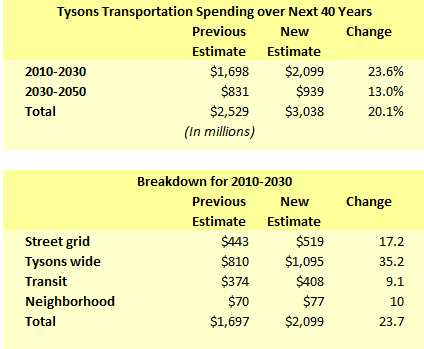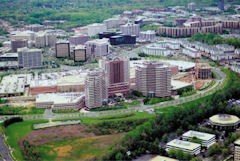How much will it cost to build the transportation improvements needed to accommodate the increased density of the new-and-improved Tysons Corner? The Fairfax Department of Transportation issued updated estimates last week at a meeting of the Tysons committee of the Fairfax County Planning Commission (PCTC) — and the estimate increased 20% from the previous best guess to more than $3 billion.
Here are the numbers:

There is a considerable fudge factor in the numbers given the inherent uncertainty of projecting so far out — and the forecast does not include an estimated $850 million to build a street car circulator within Tysons — but no matter how you add up the numbers, we are talking serious money.
The effort to morph Tysons from a monument to helter skelter, auto-centric sprawl into a model urban community is one of the most ambitious suburban retrofits ever attempted… anywhere. The centerpiece is the Rail-to-Dulles heavy rail commuter line that will connect Virginia’s largest business center to Dulles airport and to the rest of the METRO rail system. METRO will have four stations in Tysons. Fairfax County planners are playing by the smart growth handbook. They are increasing densities around METRO stops. They are planning for grid streets and pedestrian-friendly streetscapes. They are incorporating mixed uses, including thousands of units of residential. And they are requiring developers to institute Transportation Demand Management plans. Yet the question remains, can Tysons successfully make the transformation? Or was the original design, such as it was, such an abomination that business center cannot make the transition without billions of dollars of outside subsidies?
Roughly half the cost of Rail-to-Dulles will come from commuters on the Dulles Toll Road, a multi-billion dollar transfer of wealth. Now Fairfax planners are saying the county will need another $3 billion (and a lot more if inflation is taken into account) — without any idea of where the money will come from. The feds and the state might cough up some, but most of it will have to come from local sources.
In an ideal world, property owners who will make a killing from added density and proximity to the METRO should share some of the massive increase in value that they did not create. One option would be a special tax district along the lines of the existing tax district that is contributing a modest share of the heavy rail construction cost. Writes one observer:
The problem, and it’s very big problem, is that many landowners are steadfastly refusing to pay for these transportation improvements. Why, they reason, should they pay this tax when many of them do not plan to redevelop [sic] for a very long time (10-15 years or more) and when their land lies outside of the TOD areas and does not qualify for the much higher densities being given to landowners near the Metro stations. Also, Lerner and Macerich, who are inside the [Transit Oriented Development] area, have already obtained county approval for their significant redevelopments and see no benefit in paying this tax.
The reality is the landowners outside the 1/2-mile TOD areas WILL benefit from the transportation improvements, but they don’t want to pay as they feel the TOD area landowners lopsidedly benefit. These problems associated with establishing a Tysons tax district are well-known within the Tysons landowner community, but this was the first time [the Tysons Partnership] has discussed them in public testimony at a PCTC meeting.
Another problem is that, by state law, any money raised from a tax district must be spent within the district. Yet many of the needed transportation improvements are located outside of Tysons.
The improvements are so expensive, there are so many special interests jostling for position and the legal issues are such a thicket that it’s hard to see how the funding issues will ever be resolved. But there is one very important point to keep in mind. If commercial and residential growth doesn’t go into Tysons, where else will it go? And how much will it cost to provide the transportation infrastructure needed to serve it? Fairfax County is in so deep that it has no choice but to bull ahead and figure out how to make it work. Let’s hope they can do it without sucking in too many innocent bystanders.



